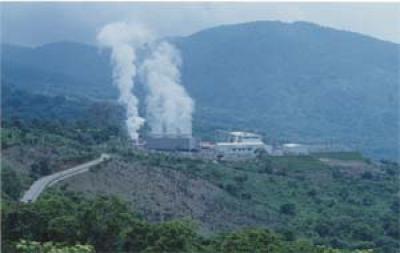In the debate over alternative energy resources, geothermal technology has received scant media attention. Advocates call it one of the cleanest, sustainable energy resources available. However, steep construction, equipment and drilling costs have prevented more widespread development of geothermal technology. An Ohio University hydrothermal systems expert is working to change that. Geothermal power plants harness energy created by heat at the Earth's core. Credit: Dina Lopez/Ohio University
Geothermal power plants harness energy created by heat at the Earth's core. Credit: Dina Lopez/Ohio University
Geothermal technology harnesses energy created by heat at the Earth’s core. Internationally, geothermal power plants supply electricity to about 60 million people, mostly in developing countries. In the United States, geothermal power plants supply four million residents with electricity. Power plants are built where there is access to a geothermal reservoir, which typically occurs along continental plate margins. The Pacific "Ring of Fire" provides some of the hottest spots on the planet for geothermal power. Because of this, Central America is a prime building area for geothermal power plants and draws researchers such as Ohio University hydrogeochemist Dina Lopez.
Lopez recently completed a study in El Salvador of one of the biggest problems plaguing the geothermal industry. That study earned Lopez and her co-authors a best paper award from the Geothermal Resources Council.
The researchers integrated findings from several studies examining the process of silica scaling. Power plants are built at geothermal reservoirs, where wells release steam, heat or hot water to spin turbine generators and produce electricity. Silica, which is released from dissolving rock, is a common element found in water. After extraction from the reservoirs, hot water cools down and silica precipitates, forming hard, glassy deposits that clog pipelines and injection drill holes at geothermal plants. Removing the silica buildup is costly and difficult due to the high volumes of water involved.
Lopez, an associate professor of geological sciences at Ohio University, and her co-authors created a model to better understand the impact of silica scaling and the rate at which it occurs. Their research shows that a combination of experimental field work and geochemical modeling programs can provide accurate indicators of the impact of silica scaling in geothermal wells.
"We used simple experiments to show the big picture," said Lopez, who believes the group’s findings will help guide efforts to control silica scaling at geothermal power plants. Better control of silica scaling will help reduce the cost of maintaining geothermal plants. That’s good news for Lopez, who hopes her research will encourage the use of geothermal energy, which she says has been overshadowed by the debate over nuclear energy and the public’s reliance on fossil fuels.
"Geothermal energy has enormous potential," she said. "There are hundreds of geothermal fields in the world, but they haven’t been exploited because of our ability to easily get energy from oil and other sources."
M. Castro and J. Reyes Lopez from the University of Baja California, Mexicali, Mexico, and A. Matus, W. Guevara, F. Montalvo and C.E. Guerra from LaGeo, El Salvador, co-authored the paper presented at the annual meeting of the Geothermal Resources Council.
Written from a news release by Ohio University.